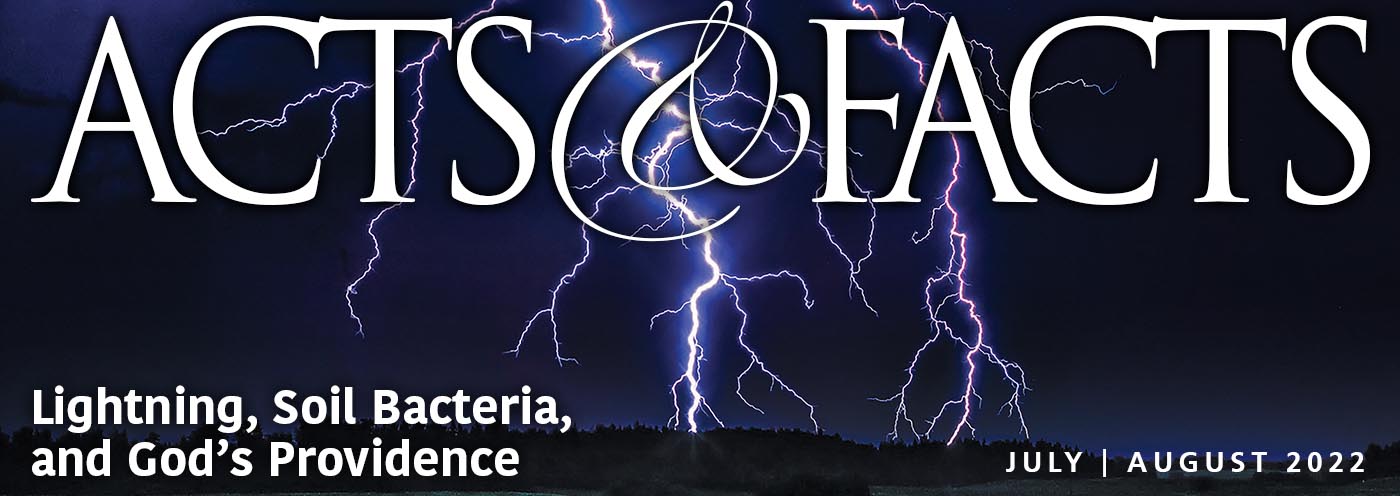A new review paper published in the journal Expert Review of Proteomics summarizes 85 reports of organic remains in fossils.1 Some of the reports describe whole tissues like blood vessels, dried but intact skin, and connective tissues on or inside fossils like dinosaur bones. Other reports describe whole cells like red blood cells and bone cells. Other reports in the review paper describe biochemicals specific to animals (not microbes), including proteins, collagen, elastin, ovalbumin, and keratin. All these reports revealed three trends that call for a vast rethink of the mainstream age of fossils.
The first trend describes a diversity of organic material among different types of fossils. Since the 1960s, researchers have reported on what appear to be original biological material in many fossils allegedly to be millions of years old. These biological remnants occur in dinosaur, bird, mammal, plant, reptile, amphibian, clam, insect and other arthropods, sponge, and worm fossils.
A second trend involves geography. The study authors noted the extent of biomaterials in fossils covers most of Earth. Some researchers even described their results taken from offshore fossils. Literature describes these remnants in fossils from North America, South America, a few in Africa, Europe (including Belgium, UK, and Spain), and Asia (featuring India and China). So far, only Antarctica and Australia lack fresh-looking fossils.
Amino acids found in a tree stump fossil might, if published technically, add Antarctica to the list.2 Australia’s inclusion may just be a matter of investigative time and effort. Thus, this second trend finds that fossil biomaterials span the globe. Shouldn’t a global effect call for a global cause?
Third, the study authors noted extensive geology. Over the last fifty years, hundreds of fossil experts have found specimens that apparently contain original biomaterials from most of the ten iconic geological systems. The researchers tallied a high number of finds from Cretaceous layers, and some reports from Jurassic, Triassic, Pennsylvanian, Silurian, and Cambrian. The most surprising protein remnants were found in layers below the Cambrian. These lowermost strata bear age assignments far older than 500 million years—a clear mismatch with expected protein chemical lifespans.
The review paper noted that biomaterials like proteins always decay over time, and that experiments show that although some might last thousands of years, none should last millions. The study authors therefore had to admit to the ridiculously huge difference between experimental expectations and the actual fossil finds and the dates traditionally ascribed to them. Biomaterial preservation appears not to care about creature kinds, continents, or even rock layers. Organic remains could pop up anywhere one finds fossils. In the end, readers are left to find their own ways to explain these three trends from the 85 scientific reports.
References
1. Thomas, B., and S. Taylor. Proteomes of the Past: The Pursuit of Proteins in Paleontology. Expert Review of Proteomics. Published online before print, December 12, 2019.
2. Pappas, S. 280-Million-Year-Old Fossil Forest Discovered in … Antarctica. LiveScience. Posted on livescience.com November 15, 2017, accessed December 16, 2019.
Eighty-Five Reports of Biological Remnants in Fossils
The Latest
July 2025 ICR Wallpaper
"These things I have spoken to you, that in Me you may have peace. In the world you will have tribulation; but be of good cheer, I have overcome...
Valued Longtime ICR Employee Mary Smith Retires
Mary Morris Smith, an employee of the Institute for Creation Research for many years, has retired. The second daughter of ICR founder Dr. Henry M. Morris...
Man of Science, Man of God: George Washington Carver
Who: George Washington Carver
What: Father of Modern Agriculture
When: 1864 or 1865 – January 5, 1943
Where: Diamond Grove,...
The Scopes Monkey Trial: A Battle of Worldviews
Rhea County Courthouse in Dayton, Tennessee, and its statue of William Jennings Bryan
Image credit: M. Mueller
The Scopes Monkey...
Long Non-Coding RNAs: The Unsung Heroes of the Genome
Evolutionary theory holds that all living things came about through random, natural processes. So conventional scientists believe the genome has developed...
Yosemite National Park, Part 1: Tiny Clues of a Grand Picture
Yosemite National Park in California is a sure source of stunning scenery. It’s no wonder that American naturalist John Muir persuaded President...
From Inference to Theory: A Common Design Case Study
Without a doubt, humans, chimpanzees, and other organisms share similar features. An early explanation was that these features reflect similar designs...
Creation Kids: T. rex
by Michael Stamp and Susan Windsor*
You're never too young to be a creation scientist and explore our Creator's world. Kids, discover...
Entering By The Door
Recently, I hosted a visiting pastor from a large church at ICR’s Discovery Center. As I guided him through our Dallas museum, one conversation...
Creation Mission in Fiji
Michele discusses pages from Explore the World with boys at an orphanage
Image credit: Brian Thomas
In 2024 my wife, Michele,...




















